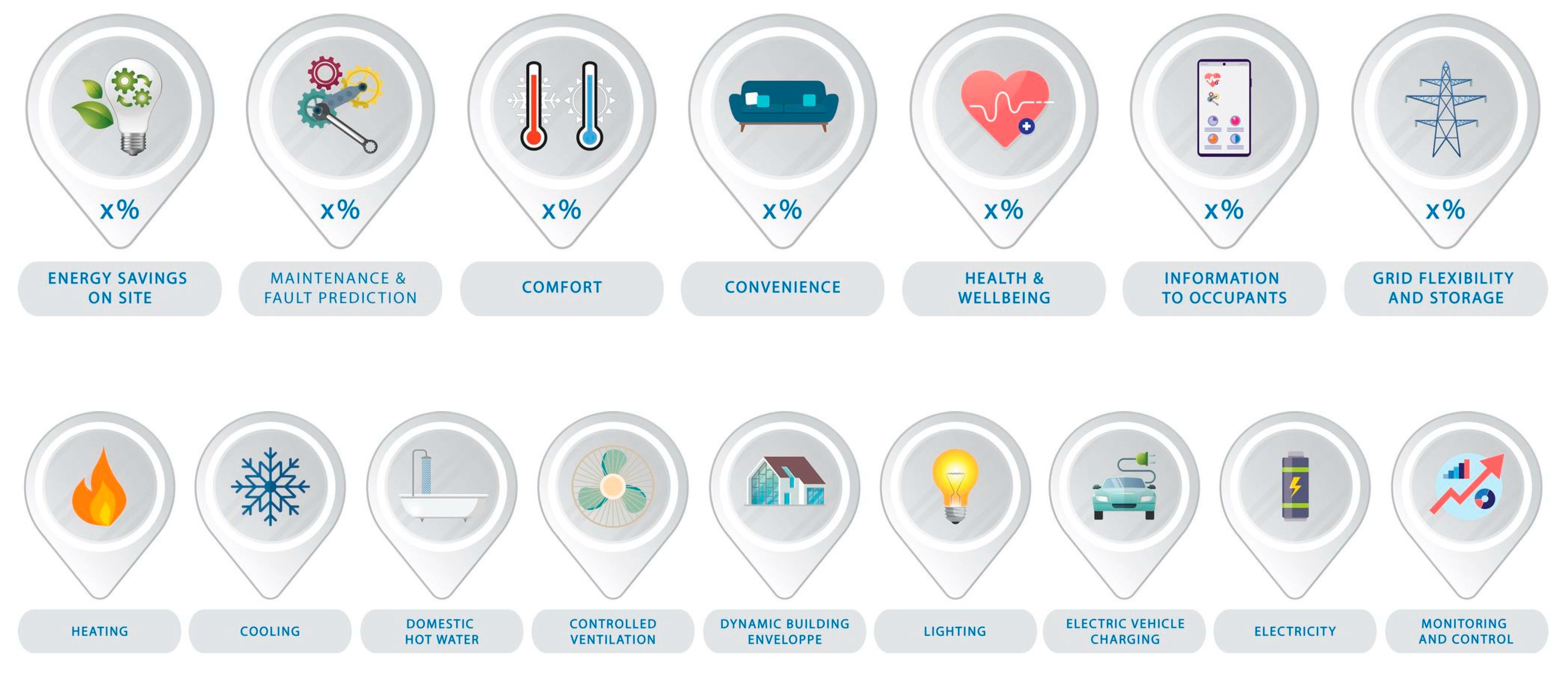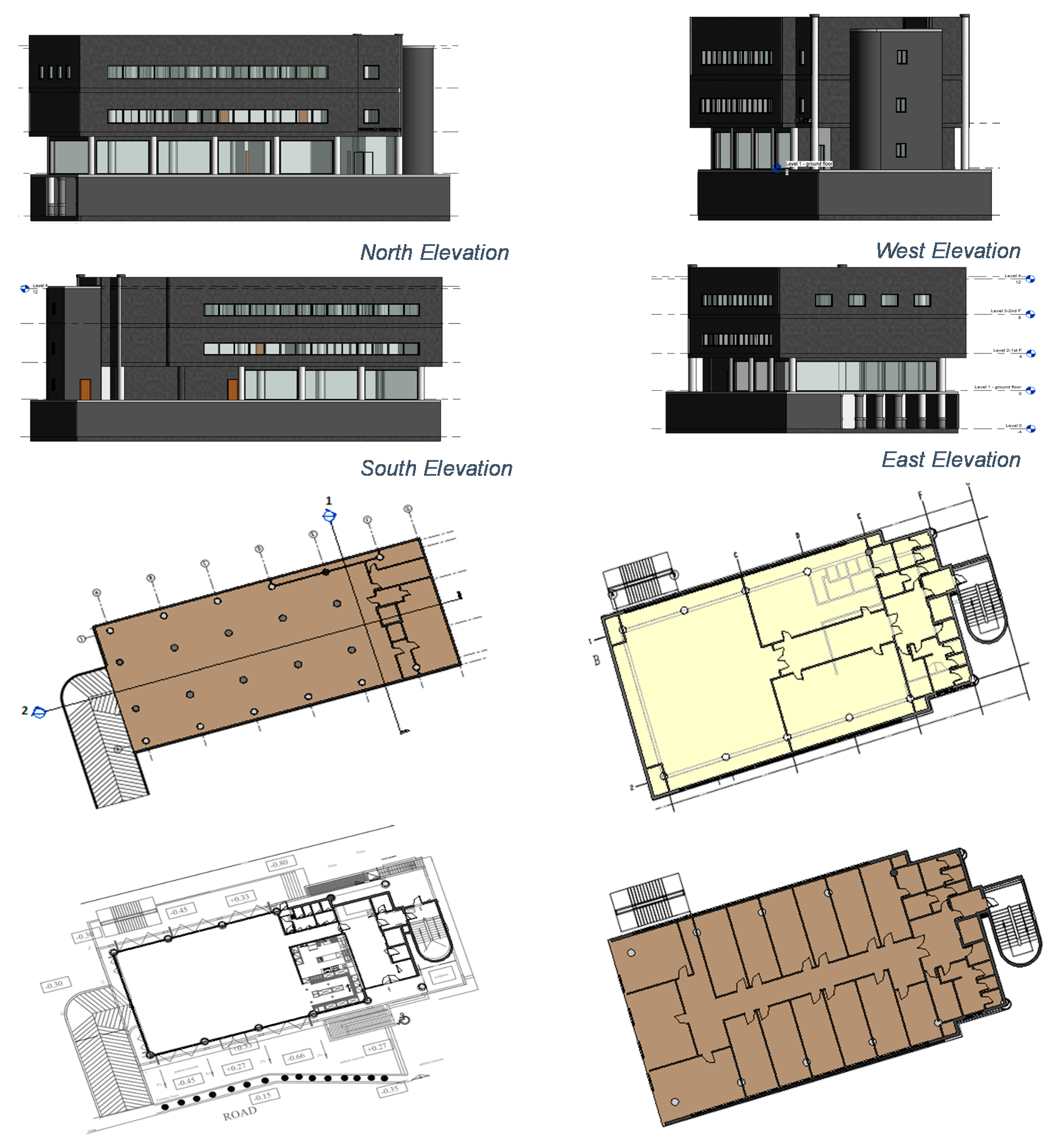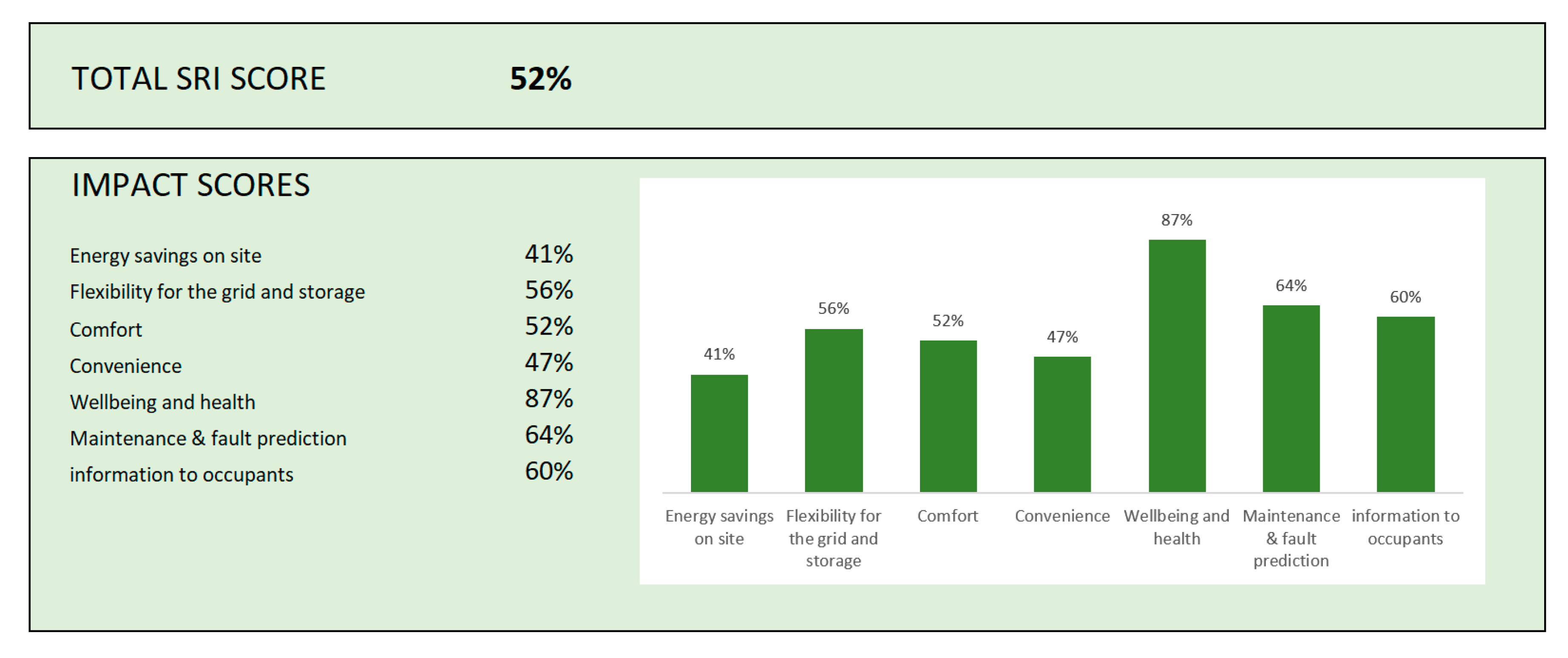How Are the Smart Readiness Indicators Expected to Affect the Energy Performance of Buildings: First Evidence and Perspectives
Abstract
1. Introduction
2. Provisions of EPBD Recast (2018/844) on Smart Readiness Indicator
2.1. EPBD Recast
- The ability to adjust the energy consumption based on the demand of the users while maintaining energy efficiency levels;
- The ability to adapt the operation of the building according to the occupants’ needs, considering human comfort conditions and providing the users with information about energy consumption;
- The building’s flexibility in the overall electricity demand, including its ability to participate in both active and passive demand as well as its direct and indirect response to grid demand.
2.2. Support for Setting Up a Smart Readiness Indicator—Current Status of Implementation
3. The Smart Readiness Indicator Assessment Scheme
3.1. Smart Readiness Indicator Domains Assessment
- Heating;
- Cooling;
- Domestic hot water;
- Controlled ventilation;
- Lighting;
- Dynamic building envelope;
- Demand side management;
- Electric vehicle charging;
- Monitoring and control.
- Heating and cooling systems are assessed based on ten individual elements, four of which are also evaluated in the simplified scheme. Τhe heat emission units are rated according to the units’ control. The smartness scales consider different levels of control including central, individual or even occupancy detection control, the latter being the smartest level. Heat generators’ intelligence is defined according to the variance in temperature control, which may depend on the ambient temperature or on the heating load. The fluid distribution network is assessed in accordance with the use of compensation and demand-based control. The functionality levels of the heat storage assess the availability of storage vessels and the capability of heat storage control with the use of external signals. As far as the distribution pumps are concerned, their functionality levels depend on the pump speed control. Similar functionality levels are also applied for heat pump units. Other building services which are included in the heating system rating include the performance of thermal activated building systems (TABS), the sequencing of the performance of different heat generators and the interaction of the heating system with the grid. Reporting of the performance of heating systems is similar in several domains and considers the real-time and historical data logging, as well as the preventive maintenance ability of the systems. Similar domains are also assessed for cooling systems. An additional element considered in cooling systems is the interlock of heating and cooling in the same thermal zone (“no interlock”, “partial”, “total interlock avoiding simultaneous heating and cooling”);
- The assessment of domestic hot water is based on five categories. The domain is evaluated according to the energy source for heating, namely thermal boiler, electric heating with element, or heat pump and solar heating. For each of these services, the functionality levels range from on/off to demand and grid-oriented supply. Sequencing and reporting are also considered as performance criteria;
- Lighting systems are rated according to the control of the lighting system (on/off, dimmable, occupancy sensors) and the interaction between the artificial and natural lighting in a space;
- Controlled ventilation systems are assessed based on six categories, according to air flow, air temperature, heat recovery, free cooling and indoor air quality (IAQ). The air flow control at the room level is rated according to its control functions. The air flow control ranges from on/off to automatic control. The prevention of overheating is defined according to sensors in air exhaust or multiple temperature sensors. The air temperature control at the air handling unit level are rated based on the control of the set temperature of ventilation. The free cooling with the mechanical ventilation system is assessed in accordance with the night cooling, free cooling and H,x-directed control. Another performance criterion for this domain is the reporting information regarding IAQ;
- Dynamic building envelope domain is evaluated in window shading systems with rating levels scaled according to the existence of manual or automatic control and if there is control based on combination with HVAC and predictive blind control;
- The assessment of demand side management is based on seven criteria. Storage of electricity is one of the categories and is evaluated according to the technology energy that is stored. The optimizing self-consumption of locally generated electricity is defined according to the scheduled or automated management of electricity consumption based on renewable energy availability and predicted energy needs. The combined heat and power plant (CHP) is rated according to the different levels of control, based on scheduled management, on RES availability and the correlation with the grid. Support of grid operation modes is also an assessed criterion and is defined according to the variance in the automated management of electricity consumption and supply. Reporting regarding local electricity generation, energy storage and electricity consumption is used for evaluation, considering values, historical data, real time feedback, performance and benchmarking;
- The assessment of electric vehicle charging is based on EV charging capacity where the functionality levels depend on the percentage of the parking spaces with charging points. The assessment is also based on EV charging grid balancing defined according to uncontrolled charging, and one-way and two-way controlled charging, and finally is based on the EV charging information and connectivity;
- Concerning monitoring and control, the final domain is based on eight categories. The main aspects which are examined are the run-time management of HVAC systems and the ability to detect faults in the technical buildings of systems. The occupancy detection, the central reporting, the smart grid integration and the interaction with the DSM are also rated.
3.2. Smart Readiness Indicator Worked Example
4. SRI Gaps and Future Perspectives
4.1. How Ready Are the Smart Readiness Indicators?
4.2. SRI Integration into Energy Performance Certificates
4.3. Historic Buildings-Tailored SRI
- Does not recognize realities such as the general limitations that exist in historic buildings for the installation of advanced building services and automation systems;
- Does not record the potential smart applications for controlling energy consumption in historic buildings;
- Does not propose a different system for assessing the intelligence of historic buildings.
4.4. Requirement for Sectoral SRIs
4.5. SRI Minimum Requirements for New Buildings and Cost Effectiveness
4.6. Integrating SRI into Practices of the Sustinable Built Environment
- Life cycle analysis;
- Building sustainability systems;
- Digitization of building design practices.
5. Conclusions
Author Contributions
Funding
Acknowledgments
Conflicts of Interest
References
- Economidou, M.; Todeschi, V.; Bertoldi, P.; D’Agostino, D.; Zangheri, P.; Castellazzi, L. Review of 50 years of EU energy efficiency policies for buildings. Energy Build. 2020, 225, 110322. [Google Scholar] [CrossRef]
- Fokaides, P.A.; Christoforou, E.A.; A Kalogirou, S. Legislation driven scenarios based on recent construction advancements towards the achievement of nearly zero energy dwellings in the southern European country of Cyprus. Energy 2014, 66, 588–597. [Google Scholar] [CrossRef]
- Bach, B.; Wilhelmer, D.; Palensky, P. Smart buildings, smart cities and governing innovation in the new millennium. In Proceedings of the 2010 8th IEEE International Conference on Industrial Informatics, Osaka, Japan, 13–16 July 2010; pp. 8–14. [Google Scholar]
- Charef, R.; Emmitt, S.; Alaka, H.; Fouchal, F. Building Information Modelling adoption in the European Union: An overview. J. Build. Eng. 2019, 25, 100777. [Google Scholar] [CrossRef]
- Rodrigues, E.M.G.; Osório, G.; Godina, R.; Bizuayehu, A.; Lujano-Rojas, J.; Catalão, J.P. Grid code reinforcements for deeper renewable generation in insular energy systems. Renew. Sustain. Energy Rev. 2016, 53, 163–177. [Google Scholar] [CrossRef]
- Khatoun, R.; Zeadally, S. Smart cities: Concepts, architectures, research opportunities. Commun. ACM 2016, 59, 46–57. [Google Scholar] [CrossRef]
- Lin, B.; Lin, B. On the economics of carbon pricing: Insights from econometric modeling with industry-level data. Energy Econ. 2020, 86, 104678. [Google Scholar] [CrossRef]
- European Commission. Directive (EU) 2018/844 of the European Parliament and of the Council of 30 May 2018 Amending Directive 2010/31/EU on the Energy Performance of Buildings and Directive 2012/27/EU on Energy Efficiency. 2018. Available online: https://eur-lex.europa.eu/legal-content/EN/TXT/HTML/?uri=CELEX:32018L0844&from=EN (accessed on 14 September 2020).
- European Commission. Proposal for a Directive of the European Parliament and of the Council Amending Directive 2010/31/EU on the Energy Performance of Buildings. COM (2016) 765 Final. Brussels, 30.11.2016. 2016. Available online: http://eur-lex.europa.eu/resource.html?uri=cellar:4908dc52-b7e5-11e6-9e3c-01aa75ed71a1.0023.02/DOC_1&format=PDF (accessed on 14 September 2020).
- Vigna, I.; Pernetti, R.; Pasut, W.; Lollini, R. New domain for promoting energy efficiency: Energy Flexible Building Cluster. Sustain. Cities Soc. 2018, 38, 526–533. [Google Scholar] [CrossRef]
- Jensen, S.R.; Marszal-Pomianowska, A.; Lollini, R.; Pasut, W.; Knotzer, A.; Engelmann, P.; Stafford, A.; Reynders, G. IEA EBC Annex 67 Energy Flexible Buildings. Energy Build. 2017, 155, 25–34. [Google Scholar] [CrossRef]
- Junker, R.G.; Azar, A.G.; Lopes, R.; Lindberg, K.B.; Reynders, G.; Relan, R.; Madsen, H. Characterizing the energy flexibility of buildings and districts. Appl. Energy 2018, 225, 175–182. [Google Scholar] [CrossRef]
- European Commission. Next-Generation Dynamic Digital EPCs for Enhanced Quality and User Awareness. 2020. Available online: https://cordis.europa.eu/project/id/892984 (accessed on 14 September 2020).
- Janhunen, E.; Leskinen, N.; Junnila, S.I. The Economic Viability of a Progressive Smart Building System with Power Storage. Sustainability 2020, 12, 5998. [Google Scholar] [CrossRef]
- Märzinger, T.; Österreicher, D. Extending the Application of the Smart Readiness Indicator—A Methodology for the Quantitative Assessment of the Load Shifting Potential of Smart Districts. Energies 2020, 13, 3507. [Google Scholar] [CrossRef]
- Märzinger, T.; Österreicher, D. Supporting the Smart Readiness Indicator—A Methodology to Integrate A Quantitative Assessment of the Load Shifting Potential of Smart Buildings. Energies 2019, 12, 1955. [Google Scholar] [CrossRef]
- Vigna, I.; Pernetti, R.; Pernigotto, G.; Gasparella, A. Analysis of the Building Smart Readiness Indicator Calculation: A Comparative Case-Study with Two Panels of Experts. Energies 2020, 13, 2796. [Google Scholar] [CrossRef]
- Janhunen, E.; Pulkka, L.; Säynäjoki, A.; Junnila, S.I. Applicability of the Smart Readiness Indicator for Cold Climate Countries. Buildings 2019, 9, 102. [Google Scholar] [CrossRef]
- European Commission. Personal Communication, European Commission, DG Energy, Unit C4, Energy Efficiency; European Commission: Berlin, Germany, 2020. [Google Scholar]
- VITO. Support for Setting up a Smart Readiness Indicator for Buildings and Related Impact Assessment (Tender Number ENER/C3/2016-554). 2020. Available online: https://smartreadinessindicator.eu/ (accessed on 22 September 2020).
- European Committee for Standardization. EN 15232-1:2017 Energy Performance of Buildings. Impact of Building Automation, Controls and Building Management; Modules M10-4,5,6,7,8,9,10; European Committee for Standardization: Brussels, Belgium, 2017. [Google Scholar]
- Leadership in Energy and Environmental Design (LEED) Award. Manag. Environ. Qual. Int. J. 2008, 19. [CrossRef]
- Building Research Establishment (BRE). Building Research Establishment Environmental Assessment Method (BREEAM). 2020. Available online: https://www.breeam.com/ (accessed on 14 September 2020).
- European Commission. Commission Delegated Regulation (EU) No 244/2012 of 16 January 2012 Supplementing Directive 2010/31/EU of the European Parliament and of the Council on the Energy Performance of Buildings by Establishing a Comparative Methodology Framework for Calculating Cost-Optimal Levels of Minimum Energy Performance Requirements for Buildings and Building Elements. 2012. Available online: https://eur-lex.europa.eu/LexUriServ/LexUriServ.do?uri=OJ:L:2012:081:0018:0036:EN:PDF (accessed on 14 September 2020).
- Kylili, A.; Ilic, M.; Fokaides, P.A. Whole-building Life Cycle Assessment (LCA) of a passive house of the sub-tropical climatic zone. Resour. Conserv. Recycl. 2017, 116, 169–177. [Google Scholar] [CrossRef]




| Area/Construction Date | Living Area of 2000 m2/2007 |
|---|---|
| Building materials/elements | Hollow Bricks, Plaster, Reinforced Concrete, Double Pane Glazing, Central Cooling-Heating System, BMS unit |
| Energy Usage | Total Energy consumption: 140 kWh/m2/year Heating-Cooling: 90 kWh/m2/year |
| Existing EPC scale | Class D |
| Electricity | Natural Gas | LPG | Biogas | Biomass | Diesel Oil | |
|---|---|---|---|---|---|---|
| Heating | 62,217.3 | 6193.2 | 7949.1 | 798.1 | 798.1 | 8491.8 |
| Cooling | 277,705.7 | -- | -- | -- | -- | -- |
| Interior Lighting | 63,224.9 | -- | -- | -- | -- | -- |
| Interior Equipment | 55,303.6 | -- | -- | -- | -- | -- |
| Total Primary End Uses | 458,451.6 | 402,427 | 404,183 | 397,032.3 | 397,032.3 | 404,726.1 |
Publisher’s Note: MDPI stays neutral with regard to jurisdictional claims in published maps and institutional affiliations. |
© 2020 by the authors. Licensee MDPI, Basel, Switzerland. This article is an open access article distributed under the terms and conditions of the Creative Commons Attribution (CC BY) license (http://creativecommons.org/licenses/by/4.0/).
Share and Cite
Fokaides, P.A.; Panteli, C.; Panayidou, A. How Are the Smart Readiness Indicators Expected to Affect the Energy Performance of Buildings: First Evidence and Perspectives. Sustainability 2020, 12, 9496. https://doi.org/10.3390/su12229496
Fokaides PA, Panteli C, Panayidou A. How Are the Smart Readiness Indicators Expected to Affect the Energy Performance of Buildings: First Evidence and Perspectives. Sustainability. 2020; 12(22):9496. https://doi.org/10.3390/su12229496
Chicago/Turabian StyleFokaides, Paris A., Christiana Panteli, and Andri Panayidou. 2020. "How Are the Smart Readiness Indicators Expected to Affect the Energy Performance of Buildings: First Evidence and Perspectives" Sustainability 12, no. 22: 9496. https://doi.org/10.3390/su12229496
APA StyleFokaides, P. A., Panteli, C., & Panayidou, A. (2020). How Are the Smart Readiness Indicators Expected to Affect the Energy Performance of Buildings: First Evidence and Perspectives. Sustainability, 12(22), 9496. https://doi.org/10.3390/su12229496






